Pickled cucumbers in vinegar are a perfect way to preserve cucumbers before winter. Consume them during the cold season with your favorite foods. This article will explain to you in detail how to pickle cucumbers the easy way.
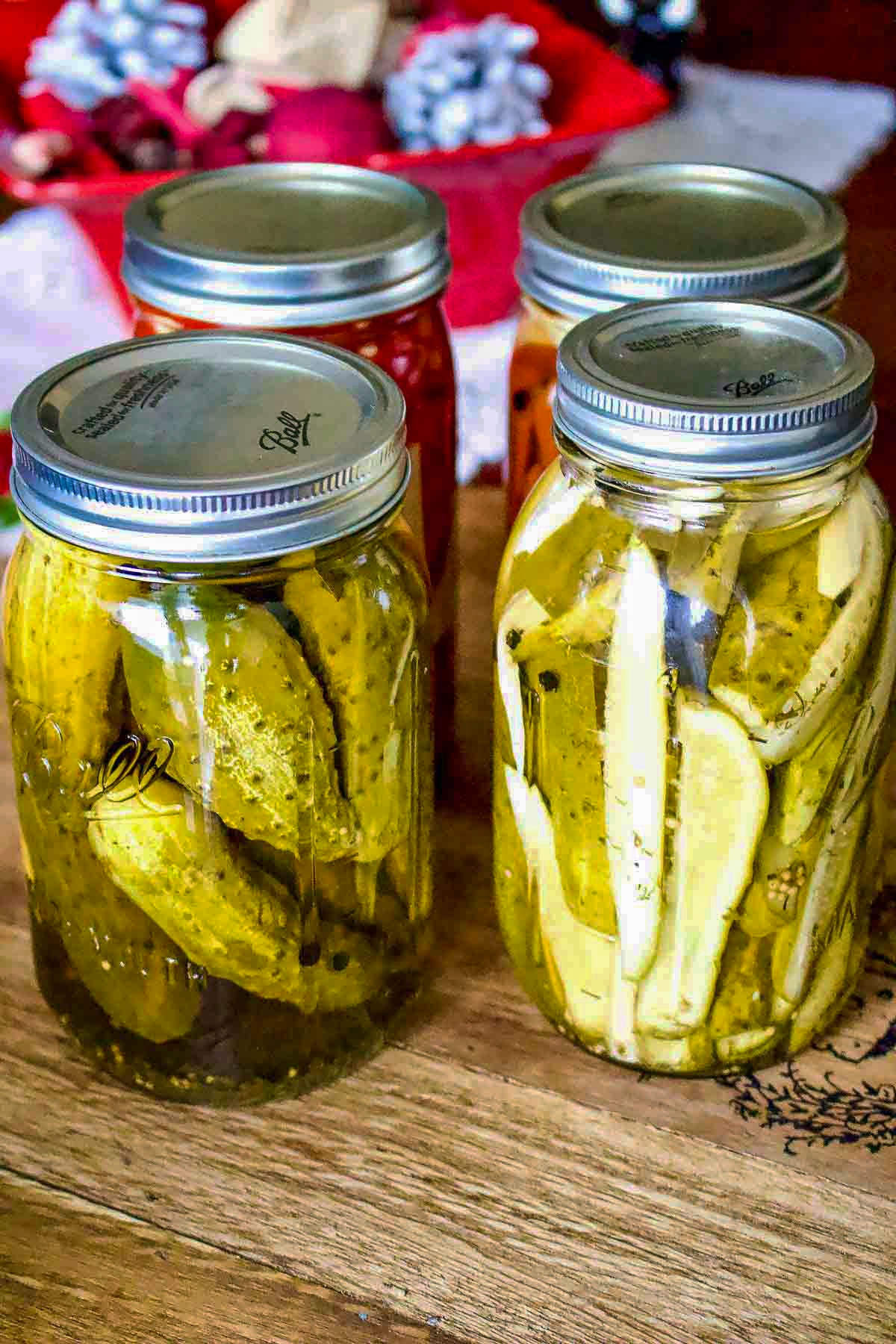
How To Pickle Cucumbers
Pickling cucumbers for long-term storage used to be a more complicated affair. However, you are about to discover an easy method for canning cucumbers that doesn't require any special skills or tools. This recipe is part of my collection of canning recipes that I hope you will enjoy.
Jump to:
- How To Pickle Cucumbers
- The Ideal Time For Pickling
- What Kind Of Cucumbers Are Good For Pickling
- Method Of Pickling: Vinegar Vs. Brine
- Key Ingredients For The Best Pickle Recipe
- The Best Formula For Pickling With Vinegar, Salt, And Sugar
- Video Recipe
- How Do You Can Cucumbers
- Expert Tip
- Serving Suggestions
- Recipe Faqs
- More Pickle Recipes To Love
- 📖 Recipe
- 💬 Comments
The Ideal Time For Pickling
If you live in a temperate climate with four seasons, late August to late October is the perfect time to prepare for the long winter months. It's time to pickle beautiful vegetables from the Farmer's Market and personal gardens!
Now, you might ask me why I preserve food when I can just go to the store and buy pickles already in jars and ready to eat. I could, but you see, there is something therapeutic about being in the kitchen and making food for my family.
Some would say that the amount of work is not worth it. I will say that for me, it is very important, as I get the opportunity to preserve vegetables using old recipes inherited from my family, recipes used when canning, and preserving foods for the winter as a way of surviving.
Although my collection of cans has grown smaller over the years, I still like to make a little bit of each of my favorite recipes just to enjoy them on holidays or when I get homesick.
Pickles are well-known staples of traditional cuisine on the Old Continent, Europe. Even today, many cultures consider pickled cucumbers an important part of their diet during the winter.
In Eastern Europe, during the cold season, salads made with fresh vegetables are replaced with pickled vegetables, such as cucumbers, peppers, cabbage, cauliflower, carrots, etc.
We also make a lot of lacto-fermented foods, like sauerkraut or cucumbers in brine.
What Kind Of Cucumbers Are Good For Pickling
Different cucumber varieties offer different pickling results.
- Kirby cucumbers are small cucumbers and are very popular in Farmer's Markets. They have bumpy skins and firm flesh.
- Gherkins or cornichons are also small and perfect for pickling. In my opinion, these are the best cucumbers to pickle.
- Garden cucumbers are the most popular ones in North America. They have thick skin and lots of seeds. If you peel and seed them, they are suitable for quick pickling. I am personally not a fan of them, but I know many people who love them. These cucumbers are sold waxed in the store and need to be peeled.
- Lemon cucumbers look exactly like lemons. They are sweeter and delicious in salads and pickled.

Please refrain from using English cucumbers. They are not a good option for winter pickles, as they become softer the longer they stay in the jar. However, you can use English cucumbers for pickles in the summer if you are looking for a quick method of pickling them, especially refrigerator-pickled cucumbers.
Also, buy organic when possible. Cucumbers are part of the "Dirty dozens" vegetables containing over ten different types of pesticides. If you plan to pickle cucumbers, go to the Farmers Market first.
Method Of Pickling: Vinegar Vs. Brine
There are two methods for canning cucumbers. One method is to pickle cucumbers in vinegar, while the other method is to use brine. (salted water flavored with spices and herbs)
People in the United States usually use vinegar, but in Eastern Europe, for example, people like to pickle cucumbers in brine.
Many cultures have known for hundreds of years that fermented foods have nutritional value and are good for your gut.
An abundance of cucumbers in the summer allows you to use canned cucumber recipes that can be consumed right away. These cucumbers are fermented in the sun.
Note: If you want a fun summer recipe, I recommend my awesome summer lacto-fermented cucumbers.
On the other hand, in the old days, most pickling was done to store food for the winter. Without canned food, people wouldn't have anything to eat. Even today, when bad weather hits, and people rush to the grocery store, they usually buy canned foods.
Today, I'm sharing my recipe for pickling cucumbers with vinegar. This dill pickle recipe is easy to prepare, and you don't need any fancy equipment or science knowledge. This recipe is great for keeping pickles for a long time. It's not a quick pickle recipe or one for refrigerator pickles.
Key Ingredients For The Best Pickle Recipe

- Cucumbers (4-6 inches, 4 pounds): The key component of this recipe. Aim for firm and fresh cucumbers, preferably pickling cucumbers. Kirby cucumbers, Gherkins, or Cornichons are perfect for pickling.
- Garlic (1 head): Adds depth of flavor. If garlic isn't your thing or you're allergic, you can leave it out.
- Plain vinegar (5% acidity, 1 gallon): Preserves the cucumbers and provides the characteristic tang. I would vote for distilled white vinegar as my first choice. My second choice would be white wine vinegar. Both kinds of vinegar are widely available, inexpensive, and do not darken the vegetables like red vinegar or apple cider vinegar.
- Canning/pickling salt (4 tablespoons): This salt flavors and preserves the cucumbers. Pickling or canning salt is best as it dissolves easily and doesn't contain iodine or anti-caking agents. Kosher salt can be used as an alternative, but avoid table salt due to its iodine and anti-caking agents.
- Granulated sugar (2 tablespoons): It balances the vinegar's acidity. Sugar balances the vinegar's acidity but it is also a preservative, so please don't skip it.
- Bay leaves (5-6): Provides subtle herbal notes. If unavailable, you can omit them, though they do contribute to the depth of flavor.
- Dried thyme (1 teaspoon): Adds an earthy, slightly minty flavor. If you don't have dried thyme, you could use a pinch of fresh thyme as a substitute.
- Dried dill or whole dill stems with umbels and green seeds (6 teaspoons): This is a perfect ingredient for preserving and flavoring pickles. Dried dill can be replaced by fresh dill, but the flavor might be less potent.
- Mustard seeds (1 tablespoon): Contributes a spicy kick. If you can't find mustard seeds, dry mustard could be used, but it might alter the flavor slightly.
- Black peppercorns (1-2 tablespoons): They add a small amount of heat. If peppercorns aren't available, some ground black pepper can work as a replacement.
- Horseradish root (1, cleaned and sliced into strips): Imparts a potent, spicy flavor. If you can't find horseradish root, a small amount of prepared horseradish could be used as a substitute.
Note about horseradish: Horseradish root is a hidden gem often used in Eastern European homemade pickle recipes. Don't shy away from incorporating it into your pickles! After cleaning and peeling, slice it into thin sticks that you can place in between the cucumbers and on top of the jar.
Interestingly, I did some research through some of my old American cookbooks (The Settlement Cook Book) and found a few recipes for pickles that use horseradish.
I am not sure when horseradish went away from the cucumber canning recipes, but it is an amazing preservative that keeps the vegetables crisp for long periods of time. Rest assured, the presence of horseradish won't result in spicy pickles.
The Best Formula For Pickling With Vinegar, Salt, And Sugar
As a basic rule, for each gallon of vinegar with 5% acidity, add 4 tablespoons of salt (make sure the salt is for pickles with no iodine added to it) and 2 tablespoons of granulated sugar. OR, for each liter of vinegar, add one tablespoon of salt and half a tablespoon of granulated sugar if you plan to can a smaller amount of cucumbers.
Video Recipe
How Do You Can Cucumbers
Step 1. Start with the jars. Thoroughly wash your jars with warm, soapy water or run them through the dishwasher. Then, sterilize them for safe canning. I recommend using wide-mouth quart jars to better fit the cucumbers inside.
When sterilizing the lids, make sure you do not treat them the same way as the jars. I clean them in warm water with soap and dry them well, then I just boil water and add them for 2 minutes to sit in that hot water.
Try to replace any older lids that do not look good. If they are too old or have rust, they need to be replaced.
Although recent guidelines suggest that boiling the lids is not necessary, I believe that immersing them in hot water for a few minutes prior to use provides an added assurance of safety.
Step 2. Prepare the cucumbers. Select good-quality, healthy cucumbers without defects, blemishes, or spots. Use a brush to scrub them thoroughly under running water.
If the cucumbers are too curved to fit comfortably in the jar, cut them lengthwise, as shown in the picture above. Slice the horseradish into thin, lengthy pieces that can fit in between the cucumbers.
Step 3. Pack the jars with cucumbers and other ingredients. Start filling the jars with cucumbers, cloves of garlic, black peppercorns, dried dill, and slices of horseradish. Ensure to place 1-2 pieces of horseradish on the top.

Step 4. Prepare the pickling mixture. Combine vinegar, salt, and sugar in a large pot and bring it to a boil. Incorporate bay leaves, thyme, and mustard seeds into the mix. Lower the heat and let the mixture simmer for about 2-3 minutes.
Step 5. Fill the jars with the pickling mixture. Before adding the liquid, place the jars on a metal tray. The metal distributes the heat evenly, helping to prevent the thermal shock that might cause the jars to crack.
Using a ladle, slowly pour the hot pickling mixture into the jars, fully immersing the cucumbers.
Close the jars tight and keep them in a cool location where the temperature remains above freezing. These gherkins in vinegar will not ferment, and they will stay crisp and delicious through the winter.
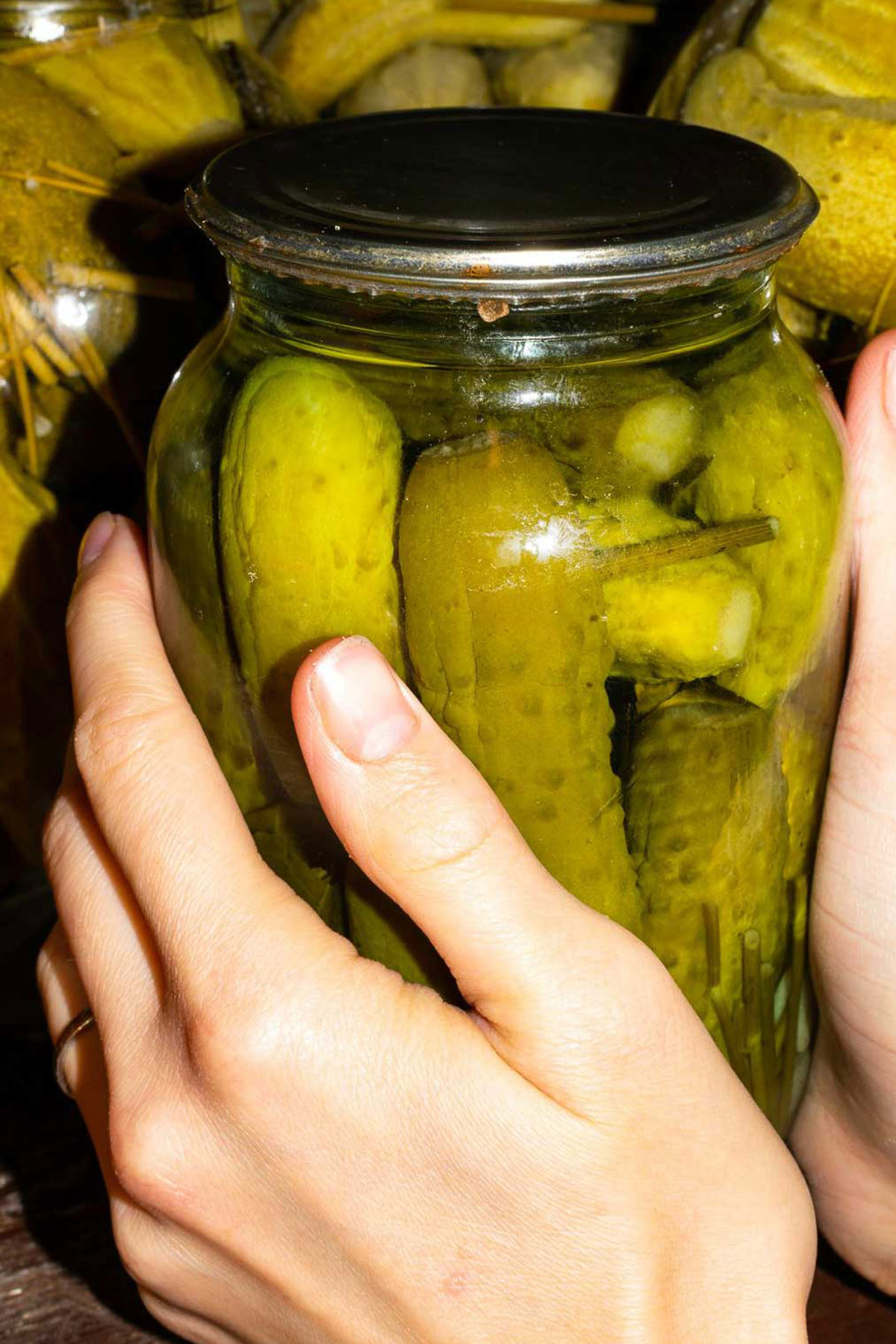
Expert Tip
The pickle jars don't require sterilization through boiling(water bath) to seal, as the vinegar isn't diluted with water as in traditional recipes. (please see the recipe faqs.)
The vinegar maintains a 5% acidity level, which is sufficient to kill any bacteria, preventing any risk of fermentation once the jar is closed tight.
You will not hear the classic pop sound when you close the jars, but this is perfectly safe.

Serving Suggestions
After a month or two, open the first jars of pickles and enjoy them throughout the winter season with stews, soups, roasted meats, beans, or potatoes.
You can also gift these beautifully colorful jars of pickled cucumbers to family or friends during the holiday season. Once a jar is opened, the pickles will last about 2-4 months in the refrigerator.
Note: Again, this is not a quick pickled cucumber recipe or refrigerator pickles. These cucumbers will not ferment and will be perfect for the wintertime. Never reuse pickle juice to make new pickles. Always use freshly made brine for the fresh cucumbers you want to can.
Recipe Faqs
For optimal flavor, the process generally takes 3-6 weeks. If you are using whole cucumbers, it might take the full six weeks, while sliced cucumbers will pickle more rapidly.
Typically, I start pickling in the cooler months of September and October and enjoy the pickles starting in late November or December.
The cucumbers in this recipe should last the whole entire winter season until May.
Absolutely! Slicing the cucumbers is completely fine. In fact, sliced cucumbers not only pickle faster, but they're also more convenient to pick from the jar.
When stored in a cool location, canned pickles can last between 1-2 years.
Vinegar, containing mild acetic acid, increases the acidity in the cucumbers and eliminates any potentially harmful microorganisms in the jars. This helps preserve the cucumbers and prevents spoilage.
No, it's not. While I do incorporate some sugar in the brine, it's primarily to balance out the vinegar's acidity and enhance the overall flavor. My preference leans towards a more salty brine than a syrupy one.
I strongly advise against reusing pickle juice for new pickles. This can lead to health risks.
Always use fresh brine for each new batch of cucumbers you want to pickle, particularly if you follow my recipe.
However, you can use leftover pickle juice in other ways, such as flavoring dips, salad dressings, or marinades.
Correct, there's no need for a water bath. Just ensure the jar lids are tightly closed before storing them in a cool place.
Vinegar destroys botulism, and this recipe uses pure vinegar. Just make sure the vinegar you use is at least 5% acetic acid.
Additional ingredients like horseradish root, mustard seeds, dill, sugar, and salt also contribute to flavor and preservation for months.
I did some research on other American recipes on the web to see how they are made. I noticed that the majority of them make a mixture of vinegar and water, spices, salt, and sugar and then process the jars for 5-10 minutes.
Dilution reduces vinegar's acidity, making it mandatory for the jars to be processed to prevent bacterial growth.
However, in this recipe, we use undiluted 5% vinegar, boiled with spices, and poured over cucumbers - no water involved. This makes the pickles more sour (which pairs well with winter roasts) and keeps bacteria at bay.
The cucumbers also need 3-6 weeks to pickle, as the process is slower compared with the method where the jars are processed in hot water.
In short, if the acidity of pickle juice drops below 3%, a water bath is needed. If the acidity stays around 5%, it isn't necessary.
If you have multiple jars, store them in a cool spot like a garage, basement, or pantry, as long as it's above-freezing temperatures. These colorful jars of cucumbers make a great gift, too!
Once opened, these pickles will remain fresh for approximately 2-4 months.

More Pickle Recipes To Love
You know that you can pickle or preserve other vegetables, right? Here is a list of my favorite recipes:
- How To Salt Preserve Herbs For Winter
- How To Freeze Herbs For Winter
- Red Peppers in Mustard Sauce
- Pickled Hot Pepper Recipe (Just Vinegar)

📖 Recipe

Pickled Cucumbers In Vinegar (Easy Recipe)
Equipment
Ingredients
- 4 pounds 4-6 inch cucumbers
- 1 head of garlic
- 1 gallon plain vinegar 5% acidity
- 4 tablespoons canning/pickling salt no iodine
- 2 tablespoons granulated sugar
- 5-6 bay leaves
- 1 teaspoon dried thyme
- 6 teaspoons dried dill or the whole dill stems with umbels and green seeds
- 1 tablespoon mustard seeds
- 1-2 tablespoons black peppercorns
- 1 horseradish root cleaned and sliced in strips
Instructions
Step 1: Preparing the Jars.
- Wash and sterilize your jars. Wide-mouth quart jars are recommended.
- Clean the lids with soapy water, dry them, and boil them for two minutes before use.
- Replace any aged or rusted lids.
Step 2: Preparing the Cucumbers.
- Choose high-quality cucumbers with no blemishes; wash them under running water.
- If necessary, cut cucumbers lengthwise to fit into jars.
- Slice the horseradish into slim pieces.
Step 3: Packing the Jars.
- Fill the jars with cucumbers, garlic cloves, black peppercorns, ¼ teaspoon of dried dill, and slices of horseradish in between.
Step 4: Preparing the Pickling Mixture.
- In a large pot, bring vinegar to a boil together with salt, and sugar. Boil for only 2-3 minutes, then add bay leaves, thyme, and mustard seeds.
- Set aside to cool for about 10 minutes.
Step 5: Filling the Jars with Pickling Mixture.
- Set jars on a metal tray to prevent cracking from thermal shock.
- Using a ladle, slowly pour the hot pickling mixture into the jars, fully immersing the cucumbers.
- Place 1-2 horseradish pieces on top of the jar to hold the cucumbers inside.
- Close the lids tight and store the jars in a cool place above freezing temperature.
Video
Notes
Expert Tips
- Sterilizing through boiling isn't necessary due to the 5% acidity level maintained by undiluted vinegar.
- Once opened, jars last for 2-4 months in the fridge.
- Avoid reusing pickle juice; always use a fresh brine.
- Enjoy the pickles throughout the winter season with stews, soups, roasted meats, beans, or potatoes. They also make a nice gift around the holidays.
- They need about a month to pickle before being consumed. These cucumbers will not ferment and will be perfect for the wintertime.

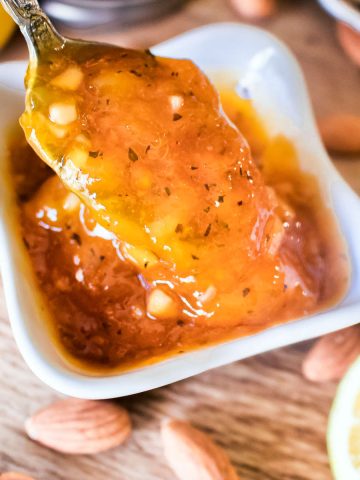
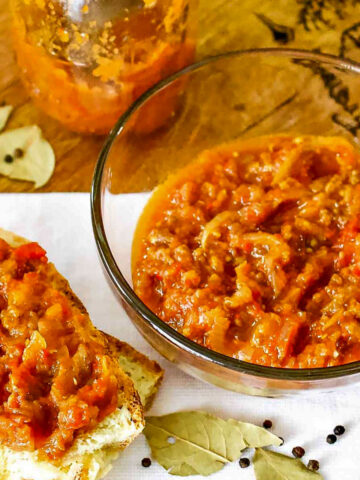
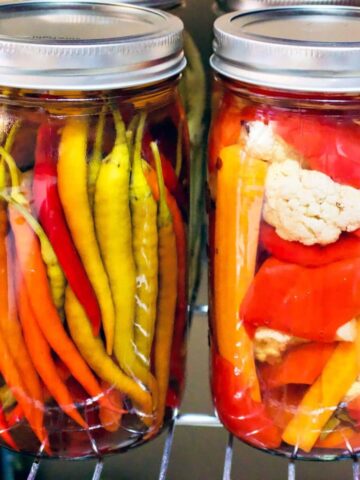

Kitchen Witch says
Hello! Today is 8/26, and my batch was done on 8/17. I noticed that, especially in my pint jars, it looks like some of the cukes drank up some of the brine volume. Is that to be expected?
Thanks!
The Bossy Kitchen says
Yes, it could happen sometimes. Are the cucumbers still covered in brine? If they are covered, they should be fine. If the cucumbers are exposed, you could make more brine, boil it, then add it to the jars and close the lid. I would consume these jars first.
Kitchen Witch says
@The Bossy Kitchen, Thanks! It looks like just a few tips of a few cukes are exposed. Topped off the jars with boiled/cooled brine. Fingers crossed!
The Bossy Kitchen says
Awesome!
Rose Adams says
Am excited to try this recipe with my extra cucumbers. Can I put in some fresh Dill instead of dried?
The Bossy Kitchen says
Yes, you can.
Joseph says
Hello again its been 2 years. gonna make pickles today using your recipe still eating hot peppers from last years October harvest. fresh dill come up its 4 feet tall came up on its own from two years ago freeze and snow don't get much of that. today its 101 texas , the dill looks like tail feathers wispy no buds or seeds rather mild don't know if I should use it. ?? made some Gravlox with it a few days ago not very strong . just picked those pickllng cukes so hot so humid like lake surface water 82 gees. have a blessed day Joseph !!!!
Denise says
Question: My family is Romanian and my aunt, mother , and grandmother all used water and salt brine with dill to pickle their pickles in the garage. Can you leave us your recipe for pickling without vinegar? (I would be so curious to try the one without the vinegar that you mentioned). Thank you!
Nina S says
Hello, hello!
I processed the jars after filling. (as an added layer of protection)
All have sealed and are hanging out in a dark, cool corner in the basement.
How long do you estimate they’ll keep if sealed and stored in the “canning corner”? Thank you!
Gabriela says
One year at least.
Nina S says
Perfect, Gabriela! Thanks so very much for sharing your recipes and knowledge! 🙂
Gabriela says
You are very welcome!
Elizabeth says
Hi. Looks great but confused about the quantity of dill. Ingredients list says 6tsp but method only mentions 1/4 tsp?
Gabriela says
There is no confusion. 6 teaspoons are for the entire quantity of cucumbers. The recipe card tells you how much dill to put in each jar, which is about 1/4 teaspoon. You can put more if you want more dill, but in general 1/4 to 1/2 teaspoon of dried dill is more than enough.
Mike E says
Five stars for the fun we had and five more for the flavor when I ate a couple out of over filled jars. Not sure what we will have in few weeks. Had a bunch (7 or 6) of big garden cucumbers wanting a home so gave this a try. Seeded the juicy ones and sliced them. Bunch of complex calculations mixed up obviously because had half the vinegar solution left. Packed jars too tight with slices or who knows what I did. Maybe I should give them a bath? Or just refrigerate? Easy recipe so will have to see what else the Boss has on here. Thanks.
Mike E says
Great recipe and when I open a jar it is gone immediately. Love the flavor and tartness. Sadly, won’t get through February. Make more next time!
Gabriela says
Thank you, Mike, for your nice comment! I am happy you enjoyed the pickles, it is a good recipe indeed!
Ash says
Kia ora Gabriela,
I had to modify the recipe to fit, I swapped out the horse radish root with whole all spice, no dill, additional heat added with chilli flakes, takes around 6 to 8 weeks before they come to my plate. Happy to wait, horse radish root is not easy to get where I live and not all pickles have to be dill. 😉
Gabriela says
You are perfectly right. Horseradish is hard to find sometimes and dill is not mandatory. However, I am happy that you adjusted the recipe to fit your taste and the ingredients availability. Let me know how the pickles taste with the whole all spice, I never had this spice in the pickles before.
Ash says
Kia ora Gabriela,
The verdict 6 weeks later:
They have turned out crunchy with the added allspice, spicy heat with the chilli flakes, now if I can stop opening the jars (canned produce) I might have some for Christmas. Hehe 😉
Regards,
Ash.
Gabriela says
Kia ora back to you, Ash! I am so happy you liked the recipe! Hide some jars for Christmas, don't eat them all! 🙂 Or make some more, they will be ready just on time! Thank you for writing back a report! You made my day! 💕
Angela says
My pickles are too sour to eat...what could be the problem?
Gabriela says
Hi there,
I'm sorry to hear that your pickles turned out too sour! This can happen sometimes, and it's usually quite easy to pinpoint the problem and avoid it in your next batch. Here are a few possibilities:
Vinegar Concentration: The main source of sourness in the pickles is the vinegar. The recipe uses plain vinegar with a 5% acidity level, which should give a balanced flavor. You might want to double-check the acidity level of the vinegar you used; sometimes, a higher concentration can lead to a much sourer end result.
Cucumber Variety: Different cucumber varieties can absorb the brine differently, leading to varied results in terms of sourness. You might want to experiment with different varieties to see which one works best for you.
Personal Taste: Everyone's taste preference can vary; it is possible that you might prefer a less sour pickle.
Brine Proportions: Ensuring the right balance of salt and sugar in your brine can be crucial. You might want to experiment with adding a bit more sugar next time to balance the sourness from the vinegar.
I hope this helps! Don't get discouraged; pickle-making is an art, and it might take a few tries to get it exactly to your taste. I'd love to hear how your next batch turns out!
Happy pickling!
Gabriela
Marianne Osborne says
My jar lids didn't seal, what did I do wrong?
Gabriela says
please read the article, the answer is there.
Fiona says
I just tried this for the first time - I’m in the UK. I poured the liquid in while it was hot, is this correct? I think the cucumbers have gone a funny colour and are now a bit soft. Have I completely messed it up?
Gabriela says
You are supposed to pour the hot liquid over the cucumbers. They should be ok. Follow the instructions closely and allow the jars to sit for a few months in a cool pantry. They should be ready to eat in about 2 months.
Lisa says
I just made these a few days ago and the garlic turned blue. Is this mold or did they turn blue from the cucumbers? Have you had this happen before?
Gabriela says
It never happened to me, but I understand your concern. However, you don't need to worry, this is a harmless reaction! It happens when the sulfur compounds in garlic react with the vinegar or trace minerals, but it’s completely safe to eat. The color change doesn’t affect the taste or safety of your pickles.
borf jorkonson says
yummy
Kylie May says
Hi Gabriela, I don't usually comment online - but this incredibly well written article deserves some praise! It provided answers to all the questions I had and more. I'm in New Zealand, where it is currently the middle of summer, and a kind elderly neighbor keeps giving me excess cucumbers from his garden. Way more than I can eat fresh.
You have given me the confidence to attempt to preserve some for later. I really appreciate that you popped in the 'Litre' comparison for our metric system here 🙂
I haven't actually made the recipe yet - but really appreciate the background information and explanations written in such an easy to understand way as that is what I was looking for.
M Schroeder says
I just made for first time! I used the reduced amount as not using 4 lbs of cukes. If I understand right, they need to sit 2 months before opening, correct.
Gabriela says
Yes, they need to sit for a while.